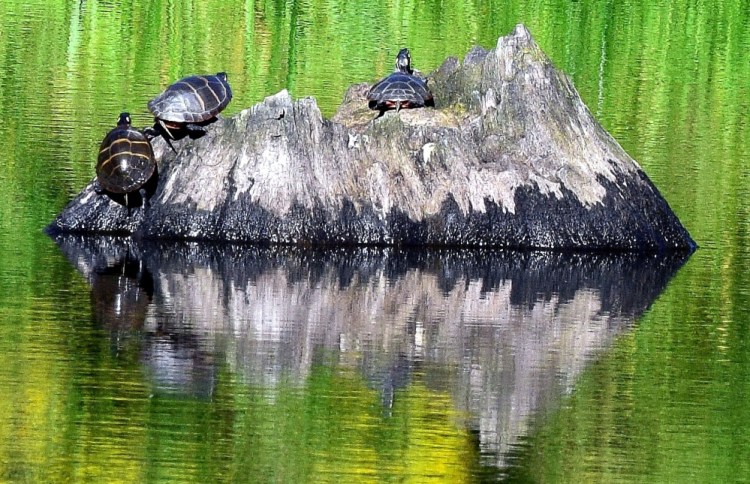Late August. Clear blue cloudless sky.
The morning walk goes first past a bending meadowsweet blossom, then farther along the driveway, a thicket full of black raspberries, prickly to pick, sweet to eat. Under the tangle, skullcaps lurk with pastel leaves and little soft blue-pink flowers. On the gravel, a pitch-glistening green pine cone and a mourning cloak testing its wings.
Up on the roadside, strips of rabbit’s foot clover buffer the whole length of the pavement. Behind it are clumps and clogs of goldenrod, and the first purple asters. Everywhere there’s space between the road and the woods, growing in droves are those mysterious white flowers that look like hemlock parsley but don’t key out right in the books. The white sweet clover that by early August was 3 feet high and bushy got cut by maintenance mowers, but out of the stubble fly grasshoppers who on this stretch of road, at least, have been practically aswarm this summer. One hovers in place like a hummingbird for 10 or 15 seconds. Astonishing.
In the farm field, dry brown rolls of hay in artistic rows. Between the horse fence and the road stands a 60- or 70-foot survivor elm. This one is so green and vital and embracing its virtues that it seems to be walking, 7 yards to a stride if it’s an inch, even as it masters its immovable spot. Constantly walking and constantly at rest.
The beaver pond is up the road behind a tangle of young oaks, spruces and juniper. I clamber up the ledge and push through the branches. A strand of spider silk lashes the nose and cheeks. When I squat near a few scraggly cedars clinging to the pond bank like sentinels, 10 or 12 ducks suddenly rattle the water and flap off in formation toward the hillside, past an ancient apple tree far up beyond the farmhouse. Specks of rust-colored ripenings are peeking from its branches at this distance.
The fringe of the other side of the pond is exposed muck this summer. To the left, two painted turtles have mounted a boulder that usually spends its summers underwater. In the mud that lines the reed grass and goldenrod territory, 15 or 20 sandpipers, most of them small and young, hop and poke their beaks in the mud. Good pickings, I guess.
White-tailed dragonflies angle back and forth over the water like silent helicopters, cut right, drop down, pop up. Two of them appear to kiss and run on the wing, and two others are full-on copulating right in the air around the boulder. Make that three painted turtles.
Beside me on the sphagnum ledge, a huge white pine with an odd divagation of trunk and branches looms over shore and head. It’s been growing on this pondside spot for at least a hundred years, I think, and maybe more. Beside it, making the most of what little soil there is, a black spruce and a small skunk spruce that can’t be 5 years old. Behind the cedars enthusiastic little maples are poking out cascades of healthy five-pointed leaves on bright red stems. For some reason these stems reach the heart. Brilliant emblems of summer morning. What could be more alive than the stem of a maple treeling?
Beavers long ago constructed a stick dam a few feet down from the pine, and normally the pond leaks through it southward, flows into a culvert and soaks into a small sloughy bog the other side of the road. But this dry summer the water doesn’t come up to the stick barrier, and so there isn’t even a trickle. I clamber back out past the juniper and skinny little oaks, inadvertently detach another spider web, then skip down the embankment and up, on the road again.
A rusty-capped sparrow (tree or swamp?) flaps around in the brush, then lights on the pavement behind me. I stop to look, and the sparrow looks back, not 6 feet away, head cocking, hopping in ineluctable perpetual small-bird motion. Special providence in the appearance of a sparrow, I think. I hope. It flies into a stand of white sweet clover that didn’t get scythed.
Back along, flying grasshoppers careen drunkenly into my face. At the driveway, I pull the newspaper out of the box. Across the street, the lawn mower of my neighbor the boat builder is in good tune.
The brook, which transpires from the bog that’s fed by the pond, is just a channel of dry glacial stones and trunks of fallen young spruces in the woods.
Back at the house, two white admirals flip along the firewood stack. A cabbage white caroms through. A bright blue dragonfly. Make that two.
Purple heal-alls like wrinkles in the grass, despite the drought. The meadowsweet. Toadflax, bright yellow. I need to get out my mowing machine, too, and clean up the lanky mouse-ear hawkweed and hemlock parsley (not) strewn around the weedy “lawn.” Not today.
A blue jay lumbers with the grace of a railroad car from red maple to poplar top. The third-quarter moon disguised by sunlight hangs between the birches in empty blue sky.
The wild madder I let grow into a bushy tangle next to the step is a green so fulsomely mature it makes you almost weep. If it be now, ’tis not to come. And it is, in natural fact, all perfectly, completely now, sunny late-August morning.
Dana Wilde lives in Troy. His new collection of naturalist essays, “Summer to Fall,” is available from North Country Press http://www.northcountrypress.com/summer-to-fall.html. You can contact him at naturalist1@dwildepress.net. Backyard Naturalist appears the second and fourth Thursdays each month.
Send questions/comments to the editors.




Comments are no longer available on this story